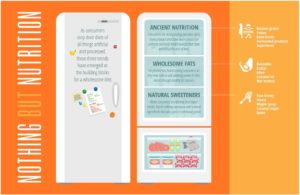 You are what you eat.
It’s a phrase that’s anything but modern, yet it’s taken on new life as consumer culture gives way to a dynamic new way of eating.
As modern lifestyles, priorities, challenges and desires have shifted, so has food culture.
Look back to the mid-20th century, when 1950s and ‘60s households shopped for food that was reliable, efficient and uniform.
You are what you eat.
It’s a phrase that’s anything but modern, yet it’s taken on new life as consumer culture gives way to a dynamic new way of eating.
As modern lifestyles, priorities, challenges and desires have shifted, so has food culture.
Look back to the mid-20th century, when 1950s and ‘60s households shopped for food that was reliable, efficient and uniform.
 Fast-forward to today, where the primary drivers of food purchases are health and wellness, experience, authenticity and distinction.
In fact, Mintel says 64 percent of consumers report that what they eat impacts their physical well-being, while 47 percent report that what they eat impacts their emotional well-being.
Culture has done a 180. Meals have become more than an item to check off the list. Consumers eat for fuel, but also as an expression of their personality, their status, their individuality.
But how did we get here? Health and wellness emerged in the 1980s as an alternative movement of the counter culture. Through the 90s and into the 2000s, wellness became an aspirational lifestyle with an added emphasis on freshness.
Today, the counterculture has gone full-blown mainstream – and food and beverage brands are responding to consumer interest in creative, innovative ways.
Fast-forward to today, where the primary drivers of food purchases are health and wellness, experience, authenticity and distinction.
In fact, Mintel says 64 percent of consumers report that what they eat impacts their physical well-being, while 47 percent report that what they eat impacts their emotional well-being.
Culture has done a 180. Meals have become more than an item to check off the list. Consumers eat for fuel, but also as an expression of their personality, their status, their individuality.
But how did we get here? Health and wellness emerged in the 1980s as an alternative movement of the counter culture. Through the 90s and into the 2000s, wellness became an aspirational lifestyle with an added emphasis on freshness.
Today, the counterculture has gone full-blown mainstream – and food and beverage brands are responding to consumer interest in creative, innovative ways.
